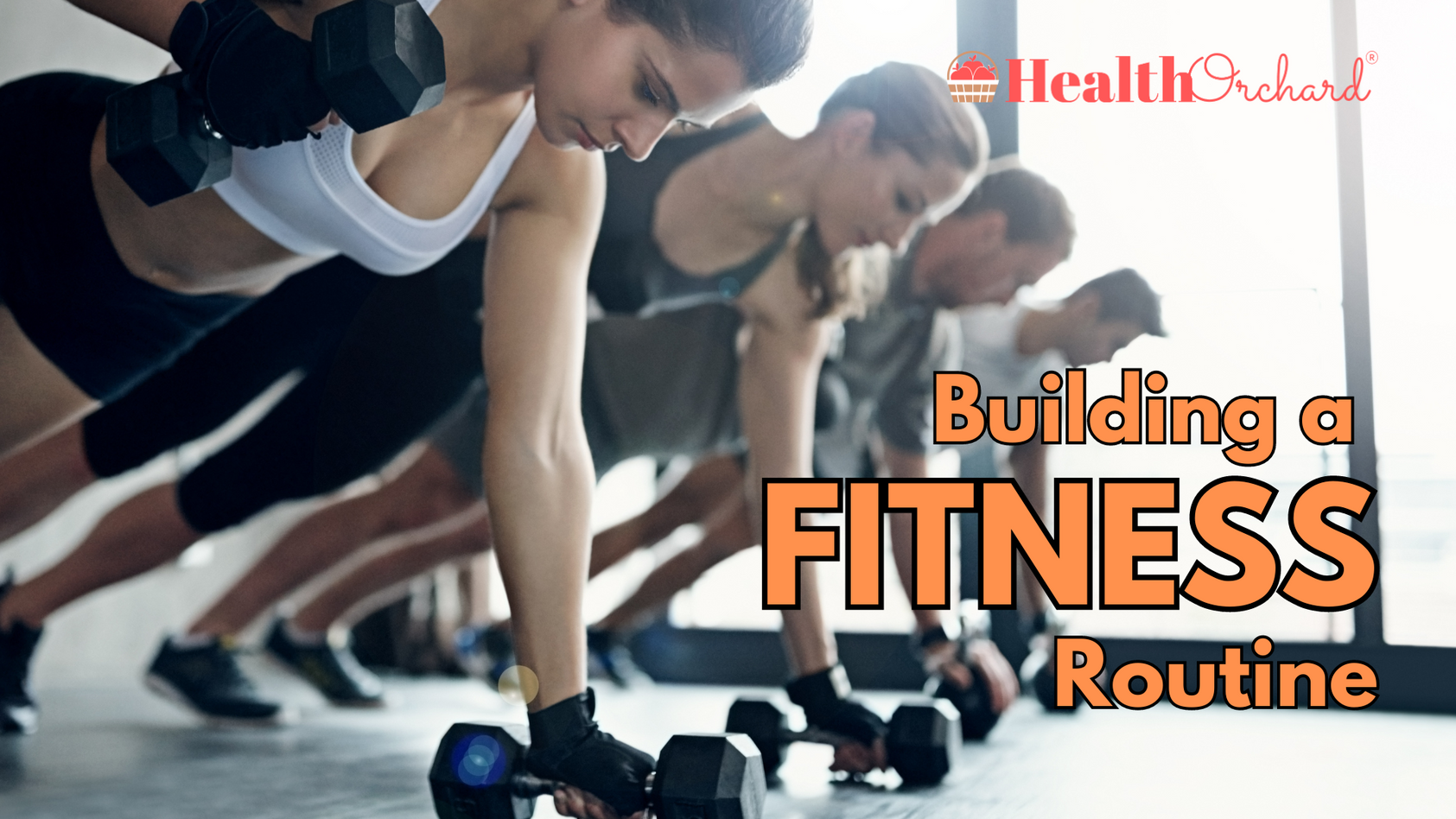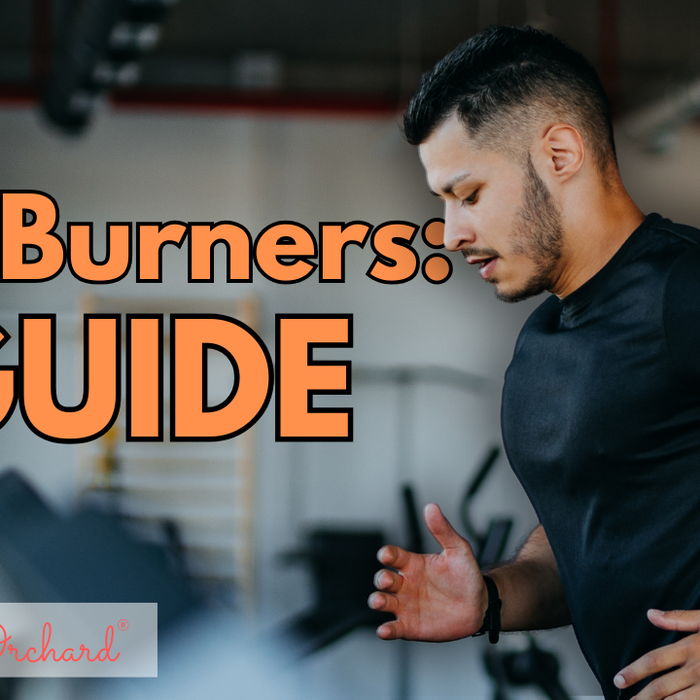

Building a Fitness Routine: Guide
Key Takeaways
- Set SMART goals: Establish specific, measurable, attainable, relevant, and time-bound fitness goals to maintain motivation and track progress effectively.
- Balance your routine: Include a mix of cardio, strength training, flexibility, and balance exercises to ensure a comprehensive fitness regimen.
- Proper nutrition and hydration: Fuel your body with balanced nutrition, including proteins, carbs, fats, and stay hydrated with water and electrolytes for optimal performance.
- Use supplements wisely: Support your fitness goals with sports vitamins, pre-workout and post-workout recovery supplements, and whey or plant-based protein.
- Stay motivated: Use strategies like setting short-term milestones, finding a workout buddy, joining a community, and tracking your progress with fitness apps and journals.
Building a fitness routine is necessary for achieving long-term health and wellness. Whether you're looking to lose weight, build muscle, or improve your overall fitness, a structured routine can help you stay motivated and track your progress.
At Health Orchard, we understand the importance of a well-rounded approach to fitness, which is why we offer a variety of health products online, at competitive prices, to support your journey, from vitamins and supplements to protein and fitness products.
Set Your Fitness Goals
How to Set Fitness Goals
The first step in building a fitness routine is setting clear and achievable goals. SMART goals—specific, measurable, attainable, relevant, and time-bound—are essential for maintaining motivation and tracking progress.
Examples of Common Fitness Goals
- Weight loss: Aim to lose a certain number of pounds over a specific period.
- Muscle gain: Set a target for muscle mass increase.
- Improved endurance: Focus on increasing the duration or intensity of your workouts.
How to Assess Your Current Fitness Level
Before starting your fitness routine, you should set a baseline to assess your current fitness level. This assessment will help you set realistic goals and track your progress over time.
Tools and Methods for Creating Your Own Fitness Assessment:
1. Fitness tests
Performing basic fitness tests can give you a good baseline to understand your starting point and measure progress over time.
- Push-ups: Test upper body strength and endurance by counting how many push-ups you can perform with proper form in one minute.
- Sit-ups: Assess core strength and endurance by counting how many sit-ups you can complete in one minute.
- Timed mile run: Measure cardiovascular endurance by timing how long it takes you to run one mile. This can be done on a track, treadmill, or a measured course.
- Plank hold: Evaluate core stability by timing how long you can hold a plank position.
- Wall sit: Assess lower body strength and endurance by timing how long you can hold a wall sit.
2. Body measurements
Tracking specific body measurements helps you monitor changes in body composition and physical size.
- Weight: Use a reliable scale to track your weight regularly. Aim to weigh yourself at the same time of day for consistency.
- Body fat percentage: Tools like body fat calipers, bioelectrical impedance scales, or professional assessments (such as DEXA scans) can provide estimates of body fat percentage.
- Waist circumference: Use a measuring tape to measure around the narrowest part of your waist. This can help track changes in abdominal fat.
- Hip circumference: Measure around the widest part of your hips to track changes in body composition.
- Chest, arm, and thigh measurements: Measure the circumference of your chest, upper arms, and thighs to monitor muscle growth and fat loss.
3. Additional methods for benchmarking your fitness level
- BMI (Body Mass Index): While not always indicative of fitness, calculating your BMI can provide a general idea of where you stand in terms of weight relative to height.
- VO2 max test: For those looking to assess their aerobic capacity, a VO2 max test (available at many fitness centers and clinics) measures the maximum amount of oxygen your body can utilize during intense exercise.
- Flexibility tests: Assess flexibility through tests like the sit-and-reach test, which measures the flexibility of your lower back and hamstring muscles.
- Balance tests: Simple tests like standing on one leg with eyes closed can help gauge your balance and stability.
How to Create a Fitness Routine
Choose the Right Type of Exercise
A balanced fitness routine should include a variety of exercise types to target different aspects of fitness.
Types of Exercises:
Cardio: Cardiovascular exercises, also known as aerobic exercises, are essential for improving heart health, increasing stamina, and burning calories. They involve continuous, rhythmic activities that elevate your heart rate.
- Running: A versatile and accessible form of cardio that can be done outdoors or on a treadmill. It helps build endurance and burn calories.
- Cycling: Whether on a stationary bike or outdoors, cycling is excellent for building leg strength and cardiovascular fitness.
- Swimming: A full-body workout that is easy on the joints, making it ideal for people of all fitness levels.
- Walking: A low-impact option perfect for beginners or those looking to maintain cardiovascular health with less strain on the body.
- Rowing: Utilizes major muscle groups in the arms, legs, and back, providing an effective cardio workout.
- Dancing: Fun and engaging, dancing can significantly improve cardiovascular fitness while enhancing coordination and flexibility.
Strength training: Strength training exercises are designed to increase muscle strength and endurance by challenging your muscles with resistance.
- Weightlifting: Using free weights or machines to perform exercises like squats, deadlifts, bench presses, and bicep curls. This helps build muscle mass and strength.
- Resistance bands: Portable and versatile, resistance bands can be used for a variety of exercises to target different muscle groups.
- Bodyweight exercises: Exercises like push-ups, pull-ups, squats, and lunges that use your body weight as resistance. These can be done anywhere and are great for building functional strength.
- Kettlebell training: Incorporates dynamic movements like swings, snatches, and cleans, providing both strength and cardiovascular benefits.
- Plyometrics: Explosive movements such as jump squats and box jumps that enhance power and athletic performance.
Flexibility: Flexibility exercises improve the range of motion in your joints and muscles, which can prevent injuries and improve overall physical performance.
- Yoga: Combines stretching, strength, and mindfulness. Different styles (e.g., Hatha, Vinyasa, Ashtanga) offer varying levels of intensity and focus.
- Stretching: Static and dynamic stretches can improve muscle elasticity and joint flexibility. Static stretching involves holding a stretch for a period, while dynamic stretching incorporates movement.
- Pilates: Focuses on strengthening the core while improving flexibility and posture through controlled movements and stretches.
Balance: Balance exercises are crucial for maintaining stability and preventing falls, especially as we age. They improve coordination and the ability to control your body's position.
- Tai Chi: A form of martial arts that involves slow, deliberate movements and deep breathing, enhancing balance and reducing stress.
- Yoga poses: Certain yoga poses, such as Tree Pose and Warrior III, specifically target and improve balance.
- Balance boards: Using devices like balance boards or stability balls can challenge your balance and improve core strength.
- Single-leg exercises: Movements like single-leg deadlifts or single-leg squats focus on stabilizing the body and enhancing balance.
Create a Balanced Weekly Fitness Plan
Designing a weekly fitness plan involves balancing different types of exercises and ensuring adequate rest and recovery.
Example Weekly Fitness Schedules and Routines:
- Beginner fitness routine:
- Monday: Cardio
- Tuesday: Strength training (upper body)
- Wednesday: Rest
- Thursday: Cardio
- Friday: Strength training (lower body)
- Saturday: Flexibility
- Sunday: Rest
- Intermediate fitness routine:
- Monday: Cardio
- Tuesday: Strength training (upper body)
- Wednesday: Cardio
- Thursday: Strength training (lower body)
- Friday: Cardio
- Saturday: Full-body strength training
- Sunday: Rest
- Advanced fitness routine:
- Monday: High-intensity interval training (HIIT)
- Tuesday: Strength training (upper body)
- Wednesday: Cardio
- Thursday: Strength training (lower body)
- Friday: HIIT
- Saturday: Full-body strength training
- Sunday: Active recovery (light yoga or walking)
Nutrition and Supplementation for Fitness Routines
Basics of Nutrition for Fitness
Proper nutrition is a cornerstone of any fitness routine. Understanding macronutrients and their roles can help you fuel your body effectively.
Macronutrients:
- Proteins: Essential for muscle repair and growth. Sources include lean meats, fish, eggs, and whey protein powder and plant-based protein products.
- Carbohydrates: Provide energy for workouts. Opt for complex carbs like whole grains, fruits, and vegetables.
- Fats: Necessary for overall health and energy. Include healthy fats from nuts, seeds, and avocados.
Hydration: Staying hydrated is crucial for performance and recovery. Aim to drink at least 8 glasses of water daily, adjusting for activity level. Consider electrolyte-rich beverages to replenish lost minerals during intense workouts.
Role of Supplements in Fitness
Supplements can play a significant role in supporting your fitness goals. They can help you recover faster, build muscle, and improve performance.
Most Popular Health and Fitness Products for Workout Routines:
- Muscle builders: Muscle builders like creatine and HMB (beta-hydroxy-beta-methylbutyrate) can help enhance muscle growth and strength.
- Pre-workout supplements: Pre-workout supplements and pre-workout stimulants boost energy and focus before workouts.
- Post-workout recovery: Post-workout recovery supplements like D-Ribose powder can help aid in muscle recovery and reduce soreness.
- Whey protein: Whey protein products like whey protein isolate, whey protein concentrate and whey protein blends provide high-quality protein for muscle repair.
- Plant-based protein: Plant-based protein like pea protein, soy protein products, and plant based protein blends are an excellent protein alternative for those avoiding animal products.
- Protein blends: Protein blend products combine different protein sources for a balanced intake.
- Sports supplements: Products like sports multivitamins and sports fish oils and omegas help support overall athletic performance.
Other Top Supplements That Support Fitness Growth
- Calcium and Vitamin D: Did you know that calcium and vitamin D are essential for bone health and muscle function? Calcium helps in muscle contraction while Vitamin D enhances calcium absorption and supports immune function.
- Vitamin B12: Crucial for energy production and the formation of red blood cells. The benefits of vitamin B12 include preventing fatigue and supporting overall metabolic function, making it particularly important for those on plant-based diets.
- 7-Keto DHEA: These lesser-known supplements can help support hormone balance and improve muscle strength and recovery, especially beneficial for those experiencing age-related declines in these hormones. Curious to learn about the difference between DHEA and 7-keto? Read more about 7-keto vs DHEA.
How to Stay Motivated and Track Your Fitness Progress
Tips for Maintaining Motivation for Your Fitness Goals
Staying motivated can be challenging, but there are several strategies to help you stay on track.
5 Motivational Tips for Sticking to a Fitness Routine:
1. Set short-term milestones
Breaking your long-term goals into smaller, achievable steps can help you stay motivated and see progress more frequently.
- Weekly goals: Aim to increase the weight you lift by a small amount each week, add an extra 5 minutes to your cardio sessions, or try a new exercise.
- Monthly challenges: Commit to completing a specific number of workouts each month or mastering a new skill, such as running a 5K or holding a plank for a certain duration.
- Performance benchmarks: Set targets like running a mile faster, increasing the number of reps for a particular exercise, or improving your flexibility with deeper stretches.
2. Find a workout buddy
Having a workout partner can add a social aspect to your fitness routine, making it more enjoyable and keeping you accountable.
- Schedule regular sessions: Plan specific times to meet with your workout buddy, ensuring you both stay committed to your routine.
- Friendly competition: Challenge each other with mini-competitions, such as who can do more push-ups or run a set distance faster.
- Mutual support: Encourage and motivate each other, celebrate successes together, and offer support when one of you is struggling to stay on track.
3. Join a fitness community
Being part of a fitness community, either online or in-person, can provide the support, motivation, and inspiration needed to maintain your routine.
- Online forums and groups: Platforms like Reddit (r/fitness), Facebook groups, or specialized fitness forums allow you to share progress, ask for advice, and connect with like-minded individuals.
- Local fitness classes: Join group fitness classes at a local gym or community center to meet new people and benefit from structured workouts led by professional instructors.
- Social media challenges: Participate in fitness challenges or follow fitness influencers on Instagram or YouTube for daily motivation, workout ideas, and a sense of belonging.
4. Set up rewards or gamify your fitness plan
Rewarding yourself for reaching milestones can provide additional motivation to stick with your routine.
- Small treats: After completing a challenging week of workouts, treat yourself to something enjoyable like a relaxing bath, a favorite meal, or a movie night.
- Fitness gear: Invest in new workout clothes, shoes, or equipment as a reward for hitting significant milestones, such as sticking to your routine for a month.
- Personal rewards: Plan larger rewards for bigger achievements, such as a weekend getaway or a spa day after reaching a major fitness goal.
5. Mix up your routine
Variety can prevent boredom and keep your workouts exciting.
- Try new classes: Experiment with different fitness classes, such as spinning, boxing, dance, or martial arts, to keep things fresh and challenging.
- Outdoor activities: Incorporate outdoor activities like hiking, cycling, or kayaking into your routine to enjoy nature while staying active.
- New workout formats: Switch up your training style by trying high-intensity interval training (HIIT), circuit training, or different strength training techniques like supersets or drop sets.
Tracking Your Fitness Journey
Tracking your progress helps you stay motivated and make necessary adjustments to your routine.
Tools and Apps to Track Your Fitness Routines:
Best apps for tracking fitness routines and progress
There are numerous apps available to help you log workouts and track progress, like:
- MyFitnessPal: Offers calorie tracking, macronutrient breakdown, and integration with other fitness devices.
- Strava: Ideal for tracking running and cycling activities, offering detailed performance analytics and a social component.
- Fitbod: Provides personalized workout plans and tracks strength training progress.
- Nike Training Club: Offers a variety of workouts and tracks your performance over time.
Best wearable devices for tracking fitness routines and progress
Fitness trackers and smartwatches are excellent tools for monitoring your activity and providing detailed insights.
- Fitbit: Tracks steps, heart rate, sleep patterns, and offers a comprehensive view of your daily activity.
- Apple Watch: Provides a range of health metrics including heart rate, activity rings, and workout tracking, along with integration with other health apps.
- Garmin: Known for its robust GPS tracking capabilities, it's ideal for outdoor activities like running, cycling, and hiking.
- Whoop: Focuses on recovery and strain, offering insights into sleep quality and workout intensity.
Best journals for tracking fitness routines and progress
Keeping a fitness journal can help you reflect on your journey and celebrate milestones.
- Bullet Journals: Allow for personalized tracking of workouts, meals, and progress, and can be tailored to your specific goals.
- Digital Journals: Apps like Evernote or OneNote can be used to log workouts, track progress, and set goals, making it easy to review and adjust your routine.
- Printable Fitness Planners: These can provide structured templates for logging workouts, nutrition, and progress, helping you stay organized and motivated.
What are the Challenges That You Might Encounter in Doing Your Fitness Program?
Dealing with Plateaus
Fitness plateaus can be frustrating, but they are a normal part of the process. Understanding and overcoming plateaus can keep you progressing toward your goals.
Strategies to Overcome Plateaus:
- Change your routine: Varying your workouts can shock your body and stimulate progress.
- Increase intensity: Gradually increase the weight or intensity of your exercises.
- Focus on recovery: Ensure you are getting enough rest and recovery time.
Preventing and Managing Workout Injuries
Injuries can derail your fitness progress, but many can be prevented with proper precautions.
Workout Injury Prevention Tips:
- Warm-up: Always start with a warm-up to prepare your body for exercise.
- Proper form: Learn and maintain proper form to avoid unnecessary strain.
- Listen to your body: Avoid pushing through pain, and give your body time to heal.
Ready to Start Your Fitness Routine?
A well-structured fitness routine is the key to success for achieving and maintaining health and wellness. By setting clear goals, designing a balanced plan, focusing on nutrition and supplementation, and staying motivated, you can make significant progress on your fitness journey.
Here at Health Orchard we offer a range of fitness and healthcare products to support your efforts, from affordable muscle builder products to competitively priced whey protein and sports supplements. Start building your personalized fitness routine today and take the first step towards a healthier, stronger you.
Buy natural supplements for health and fitness online from Health Orchard
Frequently Asked Questions about Building a Fitness Routine
1. How often should I change my fitness routine?
It's generally recommended to change your routine every 4-6 weeks to prevent plateaus and keep your workouts challenging.
2. What’s the best time of day to exercise?
The best time is when you feel most energized and can consistently fit it into your schedule. Both morning and evening workouts have their benefits.
3. How long should each workout session be?
Aim for 30-60 minutes per session, depending on your fitness level and goals. Quality is more important than duration.
4. Can I achieve my fitness goals without supplements?
Yes, but supplements can provide additional support and make it easier to meet your nutritional needs, especially if you have specific fitness goals.
5. What should I eat before and after a workout?
What to eat before a workout: A balanced meal with carbs and protein 1-2 hours before exercising.
What to eat after a workout: A post-workout meal or shake with protein and carbs within 30 minutes to aid recovery.
6. How do I stay motivated when progress slows down?
Revisit your goals, adjust your routine, and seek support from friends, family, or a fitness community. Celebrate small victories to keep yourself motivated.







